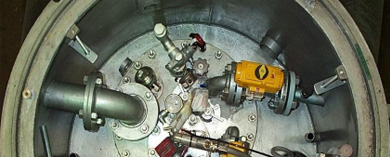
- (03) 5909 8218
- enquiry@fusionweld.com.au
Exploring phase separation dynamics
January 29, 2015

Phase separation is a core part of well stream division in a crude oil environment, but we also find the term used at the end point of the fuel distillation chain where it's perceived as a drawback. This somewhat ironic situation occurs when water damage causes a chemical reaction in an ethanol-based fuel and the blended hydrocarbon breaks down. Still, in the context of initial refinement, phase separation is an essential stage in creating the many fractions we depend on for powering the fossil fuel civilization we live in today.
Robustly engineered 2 and 3-stage separators are placed early in the oil refinement process. They're the horizontal and vertically-mounted vessels built to withstand extreme pressures and sudden temperature changes. They're constructed in spherical configurations clustered around heat exchangers and debutanizer columns, ushering in sublime solutions for splitting streams of raw gas and oil. The 3-stage configurations go further yet, removing water from the flow before moving the phase separated fluids and gases onward for additional separation, storage, or delivery to market.
Two-Phase Separation
Deals in the division of oil and gas emulsions by delivering the gas/oil mix into a series of perpendicular plates or baffles. The physical properties of the emulsion are such that the liquid component remains at the bottom of the pressurized vessel while the gaseous component is separated, whereupon it rises to the top of the container to be streamed into the gas stage of the refinement process.
Three-Phase Separation
Generally speaking, crude oil comes to the ground as an emulsion with three components. Those components are as follows, oil, gas, and water. There's also likely to be trace contaminants in the form of sulphur, but let's keep our focus on the three main constituents. It's the ratio of these three fractions that defines the many possible process configurations. For example, an excess of water would logically divert the flow to a free-water knockout stream, but the presence of large volumes of gas and oil send the mix to three-phase separation vessels. Ratios is a major factor in crude oil refinement.
Products constructed to deal with these scenarios vary greatly, but it's generally accepted that low gas-to-oil ratios are processed within vertically constructed pressure vessels while horizontal variants are tasked with separating high gas-to-oil mixes. A combination of baffles, cyclonic action, and mist extraction then combines with the assorted pressurized vessels established within the Gas-Oil Separator Plant (GOSP) to successively split the three key components.
Categorization of each separator product depends on its location in the two and three-stage separation cycle. Other factors that affect the attributes of the vessels include pressure ratings and physical construction (vertical or horizontal vessel) and the mechanical assembly within the container.
Contact Details
Fusion - Weld Engineering Pty Ltd
ABN 98 068 987619
1865 Frankston Flinders Road,
Hastings, VIC 3915
Ph: (03) 5909 8218
Optimized by NetwizardSEO.com.au
Recent Posts
- Compressed Hydrogen Storage Vessels: Material Selection, Design & Australian Standards
- Welding QA/QC in Oil & Gas Pressure Vessel Fabrication – Ensuring Code Compliance
- AS1210 vs ASME VIII Pressure Vessel Code: Key Differences for Australian Projects
- Mitigating Hydrogen-Induced Cracking in Pressure Vessels: Engineering and Material Strategies
- Storage Tank Solutions Australia: Field-Erected, Prefabricated & Self-Bunded Explained
- Reducing Environmental Risks: Self-Bunded Tanks in Australian Oil & Gas Operations
- Precision in Production: How Pressure Vessels Are Manufactured for Industrial Safety
- Shell & Tube Heat Exchangers: Improve Thermal Control & Energy Recovery in Petrochemical & Pharmaceutical Plants
- In-Service Inspection for Compressed Air Receivers for Power Plant Shutdown Prevention
- Power Plant Pipe Spooling Fabrication – Get Rapid, Code-Compliant Spools Ready for Installation
- Field Erected Tanks: Safe, Reliable On-Site Fuel Storage Solutions in Australia
- Custom Pressure Vessel Fabrication for Flammable Gases
Posts 2025
- Compressed Hydrogen Storage Vessels: Material Selection, Design & Australian Standards
- Welding QA/QC in Oil & Gas Pressure Vessel Fabrication – Ensuring Code Compliance
- View all articles…
Posts 2024
- Large Process Vessels: Optimising the Design for Maximum Efficiency [2025]
- Pressure Equipment Management System Installation: Detect Equipment Faults Early
- View all articles…
Posts 2023
- Pressure Piping System Inspection: A Gift of Safety for the Holidays
- Deaerator Inspections by Fusion-Weld Engineering and How They Reduce System Downtime
- View all articles…
Posts 2022
- How Fusion Weld Keeps Up With AS-NZS ISO 9001:2008 Standard
- Boiler Equipment Safety Inspection During the Summer Season
- View all articles…
Posts 2021
- Avoid These Factors and Practices that Contribute to Sealing Damage in Pressure Vessels
- Do's And Don'ts Of Industrial Boiler Inspection And Maintenance From Fusion-Weld
- View all articles…
Posts 2020
- What are the Risks and Hazards Involved in Pressure Vessel Equipment?
- How to Know if Your Pressure Equipment Needs Repair or Replacement?
- View all articles…
Posts 2019
- Factors that Contribute to Pressure Vessel Failure
- Pressure Vessel Regulations in Australia: What are the Mandatory Requirements?
- View all articles…
Posts 2018
- Pros and Cons of Spherical vs. Cylindrical Pressure Vessels
- What are the Different Hazard Levels in Pressure Vessels?
- View all articles…
Posts 2017
- Transportable Pressure Vessels: The Importance of Inspection and Safety Checks
- Fracture Mechanics and Stress Analysis of Cracks in Pressure Vessels
- View all articles…
Posts 2016
Posts 2015
- What Are Deaerators & Feedwater Vessels?
- Precautions and Safety for Compressed Air Receiver Vessels
- View all articles…
Posts 2014
- Demonstrating In-process Inspection Procedures
- Static Grounding Practices and Standards
- View all articles…